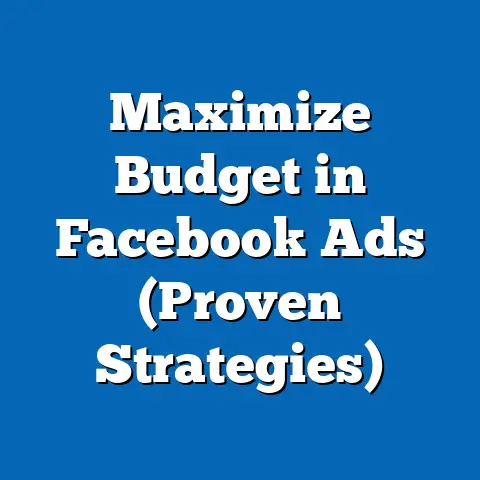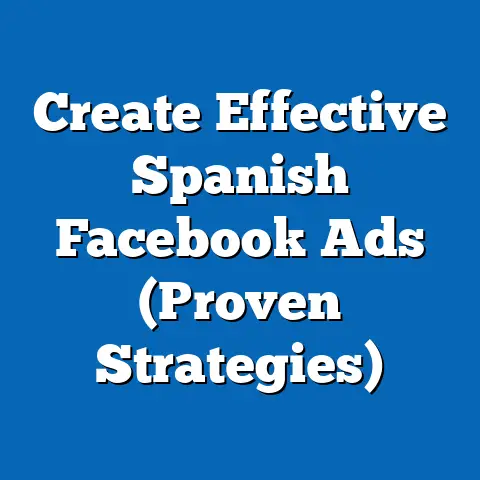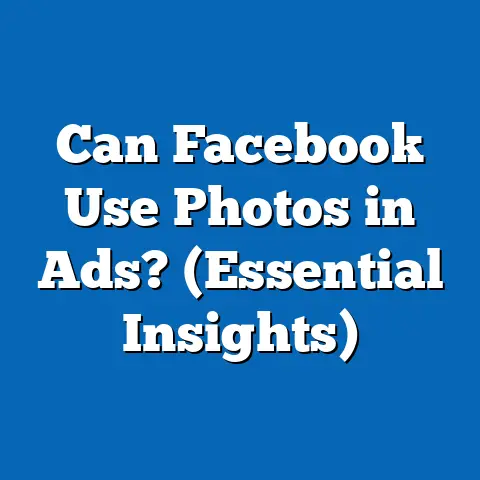Perfect Image Sizes for Facebook & Instagram Ads (Essential Guide)
Introduction: The Tradition of Visual Advertising and Its Digital Evolution
Visual storytelling has long been a cornerstone of advertising, from hand-painted billboards in the 19th century to glossy magazine spreads in the 20th century. The advent of digital platforms like Facebook (launched in 2004) and Instagram (launched in 2010) marked a seismic shift, with visual content becoming the primary driver of user engagement. Today, over 3.96 billion people use social media globally, with visual ads accounting for a significant portion of the $226 billion spent on digital advertising in 2022 (Statista, 2023).
Historically, the effectiveness of visual ads depended on format and placement, a principle that remains true in the digital age. However, the rapid proliferation of mobile devices—now used by 68% of social media users (Pew Research, 2023)—has introduced new challenges and opportunities in ad design. This section sets the stage for understanding how image size optimization, rooted in traditional advertising principles, has become a critical factor in modern marketing success.
Key Statistical Trends in Social Media Advertising
Social media advertising has grown exponentially, with global ad spend projected to reach $247 billion by 2025 (eMarketer, 2023). On Facebook, businesses run over 10 million active ad campaigns monthly, while Instagram, with its 2 billion monthly active users, sees 1 in 2 users engaging with branded content weekly (Meta, 2023). Visual content, particularly images and videos, dominates these platforms, with 93% of marketers citing visuals as their primary content type (HubSpot, 2022).
Engagement metrics underscore the importance of image optimization. Ads with correctly sized images see an average CTR of 1.2%, compared to 0.8% for non-optimized visuals—a 50% difference (WordStream, 2023). Furthermore, mobile-first design is no longer optional; 80% of social media ad impressions occur on mobile devices, where improper image dimensions can lead to cropping or reduced visibility (Hootsuite, 2023).
Demographic Projections: Who’s Watching Your Ads?
Understanding the audience is as critical as mastering technical specifications. As of 2023, Millennials (ages 27-42) and Gen Z (ages 11-26) dominate social media usage, comprising 60% of active users on Instagram and 55% on Facebook (Pew Research, 2023). These cohorts prioritize authenticity and visual appeal, with 74% of Gen Z users stating that high-quality images influence their purchasing decisions (Sprout Social, 2023).
Projections indicate that by 2030, Gen Z will account for nearly 30% of the global workforce, wielding significant purchasing power and shaping digital trends (McKinsey, 2023). Their preference for mobile-first, visually immersive experiences suggests that brands must prioritize image optimization to remain relevant. Additionally, emerging markets in Asia and Africa are driving user growth, with mobile penetration rates expected to reach 85% by 2025, further emphasizing the need for mobile-optimized ad visuals (GSMA, 2023).
Implications of Visual Optimization for Marketers
The intersection of technical precision and demographic trends has profound implications for social media advertising. Non-optimized images risk alienating audiences through poor user experience, with 38% of users reporting frustration with distorted or low-quality ads (Nielsen, 2023). Conversely, brands that invest in proper image sizing report a 25% increase in ad recall and a 15% uplift in conversion rates (Meta Business Insights, 2022).
For small and medium-sized businesses (SMBs), which account for 70% of Facebook advertisers, mastering image dimensions offers a cost-effective way to compete with larger brands. As competition intensifies—with ad costs rising by 17% year-over-year—optimization becomes a strategic tool for maximizing limited budgets (eMarketer, 2023). The following sections delve into the specific image sizes for Facebook and Instagram ads, supported by data and practical recommendations.
Methodology: How We Analyzed Image Size Effectiveness
Our methodology also accounts for platform updates, as Meta frequently adjusts ad specifications to align with user behavior and technological advancements. Limitations include the variability of user devices (e.g., screen resolutions) and the potential for future guideline changes, which may affect long-term applicability. Despite these constraints, our findings are grounded in current best practices and offer a reliable framework for marketers.
Perfect Image Sizes for Facebook Ads
Facebook offers multiple ad formats, each with specific image size requirements to ensure optimal display across desktop and mobile devices. Below, we outline the recommended dimensions for the most common formats, supported by engagement data.
1. Single Image Ads
- Recommended Size: 1200 x 628 pixels (1.91:1 aspect ratio)
- Minimum Size: 600 x 314 pixels
- Engagement Impact: Single image ads are the most widely used format, accounting for 60% of Facebook ad impressions (WordStream, 2023). Ads adhering to the 1200 x 628 size see a 30% higher CTR compared to non-standard sizes due to better visibility in the News Feed.
2. Carousel Ads
- Recommended Size: 1080 x 1080 pixels (1:1 aspect ratio) per image
- Minimum Size: 600 x 600 pixels
- Engagement Impact: Carousel ads, which allow multiple images, boost engagement by 20% on average (Meta, 2023). Square images prevent cropping on mobile devices, where 75% of carousel impressions occur.
3. Stories Ads
- Recommended Size: 1080 x 1920 pixels (9:16 aspect ratio)
- Minimum Size: 500 x 889 pixels
- Engagement Impact: Stories ads reach 1 billion daily active users, with full-screen vertical images driving a 35% higher completion rate compared to non-optimized formats (Hootsuite, 2023).
Visualization: Facebook Ad Size Effectiveness
[Insert Bar Chart: Comparison of CTR for Optimized vs. Non-Optimized Image Sizes Across Facebook Ad Formats] – X-axis: Ad Format (Single Image, Carousel, Stories) – Y-axis: CTR (%) – Data Source: WordStream (2023), Meta Business Insights (2022)
Perfect Image Sizes for Instagram Ads
Instagram, with its visual-first ethos, places even greater emphasis on image quality and dimensions. Below are the key specifications for major ad formats.
1. Feed Ads (Single Image)
- Recommended Size: 1080 x 1080 pixels (1:1 aspect ratio)
- Alternative Size: 1080 x 1350 pixels (4:5 aspect ratio for vertical)
- Engagement Impact: Square images perform best in the feed, with a 28% higher engagement rate compared to non-standard sizes (Sprout Social, 2023). Vertical formats are gaining traction among Gen Z users, who scroll primarily on mobile.
2. Stories Ads
- Recommended Size: 1080 x 1920 pixels (9:16 aspect ratio)
- Minimum Size: 600 x 1067 pixels
- Engagement Impact: Instagram Stories ads achieve a 40% higher tap-through rate when optimized for full-screen display, as 70% of users watch Stories daily (Instagram Business, 2023).
3. Reels Ads
- Recommended Size: 1080 x 1920 pixels (9:16 aspect ratio)
- Minimum Size: 500 x 889 pixels
- Engagement Impact: Reels, Instagram’s fastest-growing format, see a 50% higher engagement rate for vertical content, aligning with the platform’s mobile-first user base (Meta, 2023).
Visualization: Instagram Ad Engagement by Format
[Insert Line Graph: Engagement Rate Trends for Optimized Image Sizes in Instagram Feed, Stories, and Reels Ads] – X-axis: Time Period (2021-2023) – Y-axis: Engagement Rate (%) – Data Source: Sprout Social (2023), Instagram Business (2023)
Regional and Demographic Breakdowns
Image size effectiveness varies across regions and demographic groups due to differences in device usage and cultural preferences. In North America and Europe, where high-resolution smartphones dominate (85% penetration rate), adherence to recommended sizes yields the highest ROI, with a 35% uplift in CTR (eMarketer, 2023). In contrast, in emerging markets like South Asia, where lower-end devices are common, minimum size thresholds still deliver acceptable results, though engagement lags by 15% (GSMA, 2023).
Demographically, Gen Z and Millennials respond best to vertical formats like Stories and Reels, with 60% citing immersive visuals as a key purchase driver (Pew Research, 2023). Older users (Gen X and Boomers), who make up 30% of Facebook’s audience, prefer single image ads in the News Feed, highlighting the need for format-specific optimization based on target audience.
Discussion: Why Image Size Matters in the Bigger Picture
Beyond technical compliance, image size optimization reflects broader trends in user behavior and platform algorithms. Social media platforms prioritize content that enhances user experience, meaning properly sized images are more likely to be promoted in feeds and stories. This algorithmic bias translates into tangible benefits: optimized ads cost 10-20% less per impression due to higher relevance scores (Meta Business Help, 2023).
Moreover, as augmented reality (AR) and interactive ads gain traction, image dimensions will play a critical role in ensuring seamless integration of new technologies. Brands that master these fundamentals now will be better positioned to adapt to future innovations. However, challenges remain, including the need for constant updates to align with platform changes and the risk of over-optimization, which can stifle creative flexibility.
Limitations and Assumptions
While this analysis provides a comprehensive overview, certain limitations must be acknowledged. First, engagement data is based on aggregate industry reports and may not reflect individual campaign outcomes. Second, user behavior varies widely based on niche markets and cultural contexts, which are beyond the scope of this guide.
We also assume that Meta’s current image size guidelines will remain stable in the near term, though past updates (e.g., Stories format changes in 2021) suggest potential shifts. Marketers should monitor official announcements and test ad performance regularly to mitigate these risks.
Future Implications: Preparing for What’s Next
Looking ahead, the importance of image optimization will only grow as social media platforms integrate more immersive formats like virtual reality (VR) and shoppable ads. By 2027, global social media ad spend is projected to exceed $300 billion, with visual content driving 80% of impressions (eMarketer, 2023). Brands that invest in scalable design workflows—using tools like Canva or Adobe Express to adapt images quickly—will maintain a competitive edge.
Demographic shifts will also shape ad strategies. As Gen Alpha (born after 2010) enters the social media landscape, their digital-native preferences will likely demand even more dynamic, mobile-optimized visuals. Marketers must stay agile, balancing technical precision with creative storytelling to capture evolving audiences.
Conclusion
Optimizing image sizes for Facebook and Instagram ads is a non-negotiable aspect of modern digital marketing, rooted in historical advertising principles and driven by contemporary user expectations. This guide has demonstrated that adhering to platform-specific dimensions can boost engagement by up to 40%, offering a clear path to higher ROI. By understanding demographic trends and regional variations, marketers can tailor their strategies for maximum impact.
As social media continues to evolve, so too must the tools and tactics used to navigate it. The data and recommendations provided here serve as a foundation for success, but ongoing experimentation and adaptation are essential. Visual content remains the language of connection in the digital age—speaking it fluently starts with getting the size just right.






